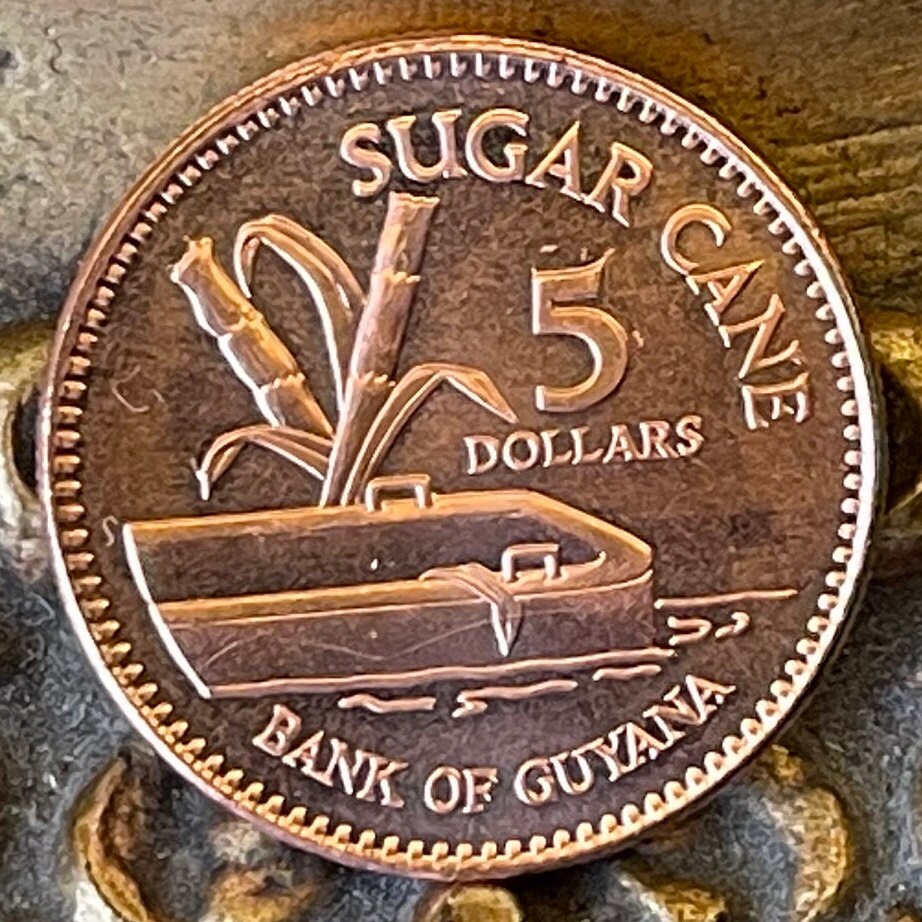elemintalshop
Flat-Bottomed Punt & Sugar Cane 5 Dollars Guyana Authentic Coin Money for Jewelry and Craft Making
Flat-Bottomed Punt & Sugar Cane 5 Dollars Guyana Authentic Coin Money for Jewelry and Craft Making
Couldn't load pickup availability
Flat-Bottomed Punt & Sugar Cane 5 Dollars Guyana Authentic Coin Money for Jewelry and Craft Making
Reverse: Sugar cane plant, and flat-bottomed punt floating in canal. There are many canals which cross the sugarcane fields. Almost one eighth of the area of the average sugarcane field is taken up by canals. This elaborate system of canals is used for irrigation. These canals are also used for transporting the canes to the factories. Sugarcane is transported in small flat bottomed boats (known as punts) from the fields to the factories.
Lettering: SUGAR CANE
5 DOLLARS
BANK OF GUYANA
Obverse: Helmeted and supported arms.
Lettering: GUYANA
ONE PEOPLE ONE NATION ONE DESTINY
Features
Issuer Guyana
Period Republic (1970-date)
Type Standard circulation coin
Years 1996-2018
Value 5 Dollars
5 GYD = 0.024 USD
Currency Dollar (decimalized, 1955-date)
Composition Copper plated steel
Weight 3.75 g
Diameter 20.5 mm
Thickness 1.8 mm
Shape Round
Orientation Medal alignment ↑↑
Number N# 3473
References KM# 51, Schön# 51
Wikipedia:
A punt is a flat-bottomed boat with a square-cut bow, designed for use in small rivers or other shallow water. Punting is boating in a punt. The punter generally propels the punt by pushing against the river bed with a pole. A punt should not be confused with a gondola, a shallow draft vessel that is structurally different, and which is propelled by an oar rather than a pole.
Punts were originally built as cargo boats or platforms for fowling and angling, but in modern times their use is almost exclusively confined to pleasure trips with passengers.
The term "punt" has also been used to indicate a smaller version of a regional type of long shore working boat, for example the Deal Galley Punt. This derives from the wide usage in coastal communities of the name "punt" for any small clinker-built open-stem general purpose boat.
In Canada, the term punt can also refer to any small flat-bottomed boat with a square-cut bow, regardless of purpose, building material, or propulsion source.
In Australia, cable ferries are commonly referred to as punts.
********
Guyana is the largest sugar producer in the Caribbean Community. Sugarcane is grown in several areas near the coast. Temperatures are high all year round and the area receives about 2000 mm of rain each year. This is good as sugarcane requires high temperatures and at least 1500 mm of rain annually to thrive. Also, there are two rainy seasons and two drier periods. Therefore, there are two sugarcane harvests per year. The sugarcane is allowed to grow during the wetter periods and harvested in the drier periods.
The soil near the coast is deep and fertile. It is therefore suitable for growing sugarcane. Most of Guyana’s population lives on the narrow coastal plain, providing the sugar estates with an adequate supply of unskilled as well as skilled labour. The main road which runs along the coast makes estates easily accessible and also provides the estates with access to other areas.
The fact that the estates are located near the coast makes it easier to export their finished product. All sugar estates are located relatively close to one of the ports from which sugar is exported. Sugar is transported by ship from Blairmont, Skeldon or Georgetown.
Growing Sugarcane
The system of sugarcane cultivation in Guyana makes controlled flooding possible. Before sugarcane is planted, the fields may be flooded for months. This kills weeds and also deposits minerals and nutrients in the soil. It also helps to control pests. This lessens the need for weedicides, pesticides and fertilizers. Parasites such as the amazon fly are used to control pests.
The planting of sugarcane is usually done by hand. Cane is usually planted in beds to aid drainage and this makes the use of machinery difficult. In some cases, the soil is too soft for heavy machinery to operate. Heavy machinery is used in only a few places.
There are many canals which cross the sugarcane fields. Almost one eighth of the area of the average sugarcane field is taken up by canals. This elaborate system of canals is used for irrigation. These canals are also used for transporting the canes to the factories. Sugarcane is transported in small flat bottomed boats (known as punts) from the fields to the factories.
Sugarcane is usually harvested manually. After the cane is harvested, the roots are sometimes left in the ground to produce new plants. This is known as ratooning. This is done up to four times. Then the fields are ploughed and replanted.
It is important to note that much of the work involved in sugarcane cultivation is done by hand. This includes planting and harvesting. Therefore sugarcane cultivation in Guyana can be described as labour intensive.
Source: https://www.geoforcxc.com/economic-activities/sugarcane-cultivation-in-guyana/
********
Wikipedia:
The coat of arms of Guyana (Co-operative Republic of Guyana) was granted by the College of Arms on 25 February 1966.
It includes a crest of an Amerindian head-dress symbolizing the indigenous people of the country, this crest is also called the Cacique's Crown; two diamonds at the sides of the head-dress representing mining industry; a helmet; two jaguars as supporters holding a pick axe, sugar cane, and a stalk of rice (symbolizing Guyana's mining, sugar and rice industries); a shield decorated with the Victoria amazonica lily, Guyana's national flower; three blue wavy lines representing the three main rivers of Guyana; and the national bird, the Canje Pheasant (Opisthocomus hoazin). The national motto, "One people, One Nation, One Destiny", appears on the scroll below the shield.
Share










5 stars review from Ernesto
I love good responsible service









